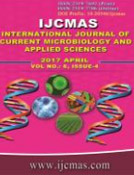


 National Academy of Agricultural Sciences (NAAS)
National Academy of Agricultural Sciences (NAAS)

|
PRINT ISSN : 2319-7692
Online ISSN : 2319-7706 Issues : 12 per year Publisher : Excellent Publishers Email : editorijcmas@gmail.com / submit@ijcmas.com Editor-in-chief: Dr.M.Prakash Index Copernicus ICV 2018: 95.39 NAAS RATING 2020: 5.38 |
Neonatal septicemia is responsible for nearly half of neonatal deaths. With emerging drug resistance mechanisms like Metallo Beta lactamase (MBL) production, treatment of neonatal sepsis has become a challenge. The present study was done to identify prevalence of bacterial pathogens, their resistance profile and incidence of MBL mediated resistance among Gram negative bacterial isolates in neonatal sepsis. Seventy three cases of suspected neonatal septicemia were included in this prospective study. Blood culture was done by BacT/Alert 3D system, bacterial isolates were identified. All Imipenem-resistant isolates were screened for the production of MβL by the Imipenem-EDTA disc method and by Imipenem with and without EDTA (IPM+EDTA/IPM) Ezy MIC E Strips test. Of 73 blood samples, 42(57.5%) showed bacterial growth. Of those, 23 were Gram positive and 19 were Gram negative. The most common pathogen was Staphylococcus aureus. Most common Gram negative isolate was Acinetobacter spp (42%). 9(47.3%) Gram negative isolates were resistant to Imipenem. Of these, 8(88.8%) showed expanded growth inhibition zone when subjected to Imipenem-EDTA disk synergy (EDS) test indicating positive MBL production and were also positive for MBL production by Ezy MIC E Strips test. The present study indicated that although Gram-positive species continue to be the predominant causative organisms in neonatal sepsis, Gram negative bacteria have a special significance due to high prevalence of Carbapenem resistance and MBL production. High prevalence of drug resistance is a matter of concern as it leaves the physician no or few options for antimicrobial therapy.
 |
 |
 |
 |
 |